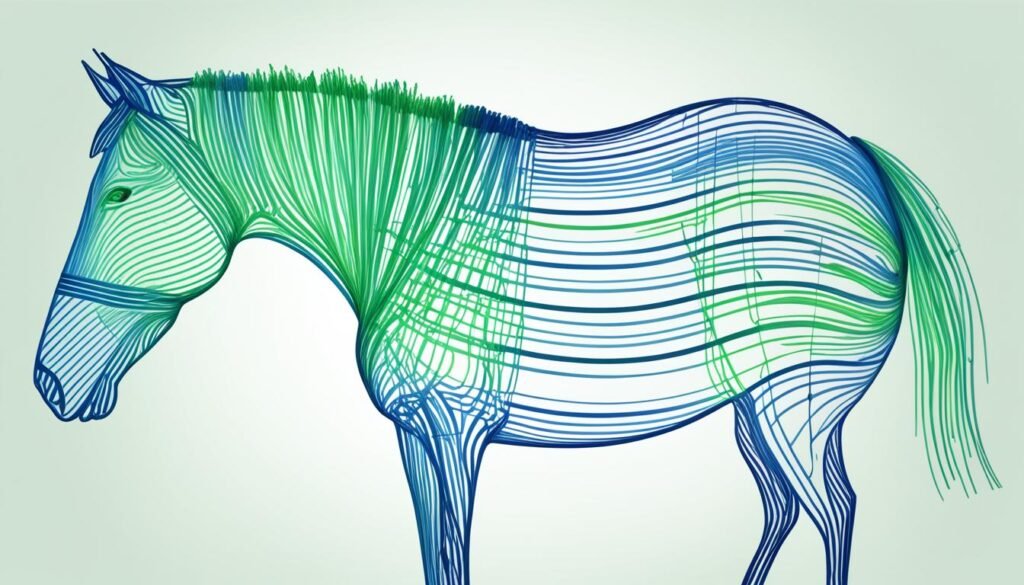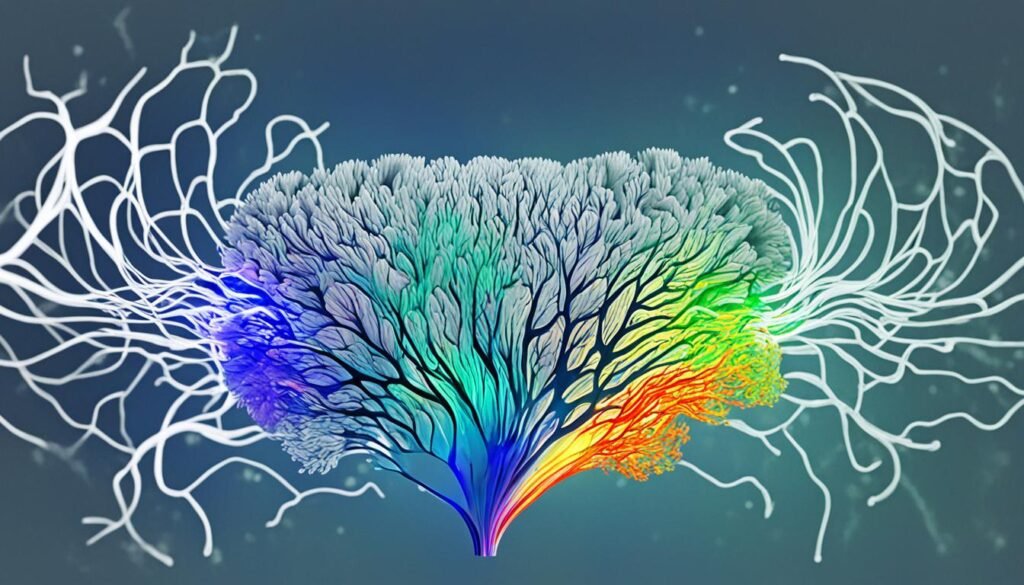In the captivating realm of equine neuroscience, researchers are delving deep into the cognitive capabilities of horses, uncovering the intricate ways these remarkable animals communicate.
By employing advanced techniques to map the brain waves of horses, scientists aim to shed light on the complex patterns that underlie equine communication, furthering our understanding of interspecies interactions and the nuances of animal cognition.
Key Takeaways
- Equine neuroscience is a rapidly evolving field that explores the cognitive abilities and communication patterns of horses.
- Mapping equine brain waves can provide valuable insights into how horses process information and interact with their environments.
- Analyzing brainwave patterns can help researchers decipher the complex language of equine vocalizations and body language.
- Understanding interspecies communication is crucial for enhancing human-horse relationships and promoting animal welfare.
- Advancements in bioacoustics, ethology, and computational neurolinguistics are shaping the future of equine research and its applications.
Introduction to Equine Neuroscience
Equine neuroscience is an exciting field that delves into the cognitive capabilities of horses, shedding light on their remarkable intelligence and communication abilities.
By exploring the intricate workings of the equine brain, researchers are uncovering the depth of Horse Intelligence and paving the way for a deeper understanding of Interspecies Communication.
Exploring the Cognitive Capabilities of Horses
Recent studies in Animal Cognition have revealed that horses possess a range of complex cognitive abilities, including problem-solving skills, emotional intelligence, and social awareness. Horses are capable of recognizing and responding to human facial expressions, understanding basic commands, and even exhibiting self-awareness.
The equine brain, while smaller than the human brain, is highly sophisticated and organized, with distinct regions responsible for various functions.
Researchers are using advanced neuroimaging techniques, such as electroencephalography (EEG), to map the Equine Neuroscience and uncover the neural underpinnings of equine behavior and communication.
The Importance of Understanding Animal Communication
Deciphering the nuances of Interspecies Communication is crucial for strengthening the bond between humans and horses, as well as improving the welfare and training of these remarkable animals. By gaining a deeper understanding of how horses communicate through vocalizations, body language, and even subtle changes in brain activity, we can enhance our ability to interpret their needs, emotions, and preferences.
This knowledge can inform more effective and humane training methods, foster stronger human-horse relationships, and ultimately improve the overall well-being of horses in various settings, from the racetrack to the therapeutic riding center.
Mapping Equine Brain Waves to Identify Communication Patterns
In the captivating realm of equine neuroscience, researchers are delving into the intricate world of Mapping Equine Brain Waves to Identify Communication Patterns.
By harnessing advanced techniques like electroencephalography (EEG), scientists can now record and analyze the electrical activity within the equine brain, shedding light on the ways in which horses communicate and interact with their environment.
This groundbreaking research aims to uncover the complex language of equine communication, a vital step in fostering a deeper understanding of Animal Behavior.
By mapping the brain waves of horses, researchers can identify distinct patterns that correspond to various vocalizations, gestures, and social interactions, ultimately deciphering the nuanced Equine Communication Patterns that have long fascinated the scientific community.
The implications of this Equine Neuroscience research are far-reaching, as it not only enhances our knowledge of equine cognition and behavior but also holds the potential to revolutionize our approach to Mapping Equine Brain Waves.
This holistic understanding of how horses process information and convey their intentions can profoundly impact fields ranging from equine-assisted therapy to animal welfare and conservation efforts.
As the exploration of Equine Communication Patterns continues, the insights gleaned from Mapping Equine Brain Waves will undoubtedly serve as a powerful catalyst for advancements in the understanding of Animal Behavior.
By unraveling the intricate neural signatures that underlie equine communication, researchers can unlock new avenues for interspecies collaboration, fostering stronger bonds and more effective communication between humans and their equine counterparts.
Brainwave Analysis Techniques
In the realm of equine neuroscience, researchers are delving deep into the fascinating world of brainwave analysis. One of the primary tools in their arsenal is electroencephalography (EEG), a non-invasive technique that allows for the measurement of electrical activity within the horse’s brain.
By harnessing the power of EEG, scientists are uncovering the intricate patterns of equine communication, gaining valuable insights into the cognitive capabilities of these majestic animals.
Electroencephalography (EEG) and Its Applications
Electroencephalography (EEG) is a revolutionary neuroscience technique that has found its way into the world of equine research. By strategically placing electrodes on the horse’s scalp, researchers can record the brain’s electrical impulses, allowing them to analyze the complex patterns of neural activity.
This cutting-edge technology provides a window into the inner workings of the equine mind, enabling scientists to study everything from emotional responses to cognitive processes.
One of the key applications of EEG in equine neuroscience is the investigation of communication patterns. By monitoring the brainwave activity of horses during various social interactions, researchers can identify the neural signatures associated with different modes of communication, such as vocal cues, body language, and even subtle shifts in mood and behavior.
This knowledge can then be used to develop more effective methods for interpreting and understanding the ways in which horses convey information to one another and to their human counterparts.

Moreover, EEG technology is also being utilized to explore the cognitive capabilities of horses, shedding light on their problem-solving abilities, learning processes, and even their capacity for emotional intelligence.
By analyzing the brainwave patterns associated with these cognitive functions, researchers can gain a deeper understanding of the inner workings of the equine mind, ultimately contributing to the advancement of the field of equine neuroscience.
As the field of equine neuroscience continues to evolve, the applications of brainwave analysis techniques, such as EEG, are poised to play an increasingly vital role in unraveling the mysteries of equine communication and cognition.
Through this cutting-edge research, we are gaining a more comprehensive understanding of the remarkable abilities of these magnificent creatures, paving the way for more effective and empathetic interactions between humans and horses.
Animal Cognition and Interspecies Communication
Exploring the intricate world of animal cognition and interspecies communication is crucial for understanding the remarkable abilities of our equine companions.
By delving into the nuanced equine vocalizations and body language, researchers can unravel the depth of horses’ cognitive capacities and how they perceive and interact with their environment.
Interpreting Equine Vocalizations and Body Language
Horses possess a diverse repertoire of vocalizations, from the familiar neighs and whinnies to more subtle grunts and snorts. Each sound conveys a unique message, reflecting the horse’s internal state, emotions, and social interactions.
Similarly, their body language, from the expressive ears to the subtle shifts in weight and posture, provides a window into the equine mind.
- Deciphering the meaning behind equine vocalizations, such as the high-pitched whinny or the low-frequency rumble, can reveal insights into the horse’s cognitive abilities and communication strategies.
- Observing the nuances of equine body language, like the flared nostrils or the tense, raised tail, can help researchers better understand how horses perceive and respond to their surroundings.
- By analyzing these interspecies communication cues, researchers can gain valuable insights into the complex social dynamics and cognitive processes of horses.
Unraveling the mysteries of animal cognition and interspecies communication is an ongoing endeavor, but the study of equine vocalizations and body language has the potential to unlock a deeper understanding of these remarkable creatures and their interactions with the world around them.
Bioacoustics and Ethology
Bioacoustics and ethology are two closely intertwined disciplines that provide invaluable insights into the intricacies of equine communication. Bioacoustics, the study of animal vocalizations, offers a profound understanding of how horses convey information through sound.
Complementing this, the field of ethology, which examines the natural behaviors and interactions of animals, sheds light on the nonverbal cues and body language that horses employ to communicate with one another and their human counterparts.
By combining these specialized fields, researchers can delve deeper into the nuanced ways in which equine behavior and animal communication intersect.
Through advanced bioacoustic analysis techniques, such as the use of high-fidelity recording equipment and sophisticated signal processing algorithms, scientists can meticulously decode the complex patterns and meanings hidden within equine vocalizations.
Meanwhile, the principles of ethology guide the observation and interpretation of horses’ physical movements, facial expressions, and herd dynamics, allowing researchers to piece together a more comprehensive understanding of how these remarkable creatures convey their thoughts, emotions, and intentions.
This multifaceted approach to the study of equine communication is crucial for developing effective methods of interspecies interaction and fostering deeper, more meaningful connections between humans and their equine counterparts.
By unraveling the intricate tapestry of bioacoustics and ethology, researchers can unlock the secrets of animal communication, paving the way for groundbreaking advancements in the fields of equine behavior and welfare.
This holistic understanding of how horses express themselves will undoubtedly lead to more effective training methods, enhanced interspecies collaboration, and a greater appreciation for the cognitive capabilities and emotional complexities of these magnificent creatures.
Computational Neurolinguistics
In the captivating realm of animal communication, a new frontier has emerged – the field of computational neurolinguistics.
By harnessing the power of Artificial Intelligence (AI) and Machine Learning (ML), researchers are now able to delve deeper into the intricate patterns of equine vocalizations and brain activity, shedding light on the complex ways in which horses communicate.
At the intersection of neuroscience, linguistics, and computer science, computational neurolinguistics offers a revolutionary approach to understanding Equine Communication Analysis.
Through the development of advanced algorithms, scientists can now analyze and interpret the nuanced expressions, body language, and vocalization patterns of horses, revealing insights that were once beyond our reach.
Leveraging Artificial Intelligence and Machine Learning
The integration of AI and ML technologies has been a game-changer in the field of Computational Neurolinguistics.
These powerful tools enable researchers to process vast amounts of data, identify complex patterns, and uncover the underlying neural mechanisms that drive equine communication.
- Electroencephalography (EEG) data analysis using AI-powered algorithms to decode brain wave patterns associated with specific communication behaviors.
- Machine Learning models trained on extensive datasets of equine vocalizations to accurately recognize and classify different types of calls and their emotional or contextual significance.
- Multimodal integration of audio, visual, and physiological data to develop comprehensive models of equine communication, incorporating both verbal and non-verbal cues.
By leveraging these cutting-edge technologies, researchers are poised to make groundbreaking discoveries that will deepen our understanding of how horses communicate, ultimately paving the way for more effective interspecies interactions and enhanced animal welfare.

Ethical Considerations in Equine Research
As the field of Equine Research continues to evolve, it is crucial to address the ethical considerations surrounding the research and its potential impact on the Animal Welfare of the animals involved.
Researchers must adhere to stringent guidelines and best practices to ensure the Ethical Considerations and Animal Rights of horses are protected during the course of their studies.
One of the primary ethical concerns in Equine Research is the well-being of the animals. Researchers must ensure that the horses involved in their studies are housed in comfortable and stress-free environments, and that any procedures or interventions are conducted with the utmost care and consideration for the animals’ physical and psychological needs.
Additionally, researchers must obtain informed consent from relevant stakeholders, such as the horses’ owners or caretakers, before conducting any research. This helps to ensure that the research is not only scientifically valid, but also ethically sound and respects the Animal Welfare of the horses involved.
Transparency and accountability are also critical in Equine Research. Researchers must be willing to share their findings and methodologies with the scientific community and the public, as this helps to build trust and ensure that the research is conducted in an ethical and responsible manner.
By addressing these Ethical Considerations and prioritizing the Animal Rights of the horses involved, researchers can help to advance the field of Equine Research in a way that is both scientifically and morally responsible.
Future Applications and Implications
The groundbreaking insights gained from mapping equine brain waves and deciphering their communication patterns have far-reaching implications. This research has the potential to revolutionize the way we understand and interact with our equine companions, ushering in a new era of interspecies cooperation and harmony.
One of the most exciting future applications of this research lies in enhancing interspecies interactions. By decoding the subtle nuances of equine communication, we can develop more effective strategies for training, care, and even therapy involving horses.
This could lead to improved animal-human relationships, fostering deeper mutual understanding and trust between species.
Furthermore, the insights gleaned from this research can be leveraged to develop innovative approaches to equine welfare and management. Understanding the cognitive capabilities and communication patterns of horses can inform the design of more humane and enriching environments, ultimately improving the overall well-being of these magnificent creatures.
Looking ahead, the potential implications of this research extend beyond the equine realm. The lessons learned from mapping equine brain waves could pave the way for advancements in the broader field of animal cognition and interspecies communication.
This knowledge can be applied to enhance our understanding and appreciation of diverse animal species, ultimately strengthening the bonds between humans and the natural world.
| Potential Future Applications | Key Benefits |
|---|---|
| Enhancing Interspecies Interactions | Improved animal-human relationships, more effective training and care strategies |
| Advancing Equine Welfare and Management | Designing more humane and enriching environments for horses, improving overall well-being |
| Broader Applications in Animal Cognition | Expanding our understanding and appreciation of diverse animal species, strengthening human-nature connections |
Conclusion
The exploration of Equine Neuroscience and the mapping of Equine Brain Waves to identify Equine Communication patterns represents a captivating and rapidly evolving field of research.
By unlocking the secrets of how horses communicate, scientists are not only advancing our understanding of these intelligent animals but also paving the way for new possibilities in Interspecies Communication and the enhancement of animal-human relationships.
Through the application of cutting-edge techniques, such as Electroencephalography (EEG) and computational neurolinguistics, researchers are gaining valuable insights into the intricate workings of the equine mind.
This knowledge can lead to improved methods of interpreting equine vocalizations, body language, and other forms of communication, ultimately fostering deeper connections and mutual understanding between horses and their human counterparts.
As the field of Equine Neuroscience continues to evolve, the potential for groundbreaking discoveries and practical applications only grows.
From advancements in animal training and welfare to the development of innovative therapies and interspecies collaborations, the implications of this research are far-reaching and hold the promise of a future where humans and horses can communicate and coexist in harmony.
FAQ
What is the focus of equine neuroscience research?
Equine neuroscience research focuses on exploring the cognitive capabilities of horses and understanding their complex communication methods.
By mapping the brain waves of horses, researchers aim to uncover the intricate patterns of equine communication and shed light on the intricacies of interspecies interaction.
How do researchers use brainwave analysis techniques to study equine communication?
Researchers utilize advanced techniques such as electroencephalography (EEG) to record and analyze the electrical activity in the equine brain.
This non-invasive technology allows them to study the brainwave patterns of horses, providing valuable insights into how they perceive and interact with their environment.
What is the role of bioacoustics and ethology in understanding equine communication?
Bioacoustics, which focuses on the analysis of animal vocalizations, and ethology, which examines the natural behaviors and interactions of animals, are integral to the study of equine communication patterns.
By combining these disciplines, researchers can gain a comprehensive understanding of how horses communicate through both vocal and non-vocal cues.
How are artificial intelligence and machine learning being used in equine communication research?
The field of computational neurolinguistics leverages artificial intelligence and machine learning to analyze and model the complex patterns of equine vocalizations and brain activity. By developing advanced algorithms, researchers can interpret and decipher the communication methods used by horses, furthering our understanding of their cognitive capabilities.
What are the ethical considerations in equine research?
As the field of equine neuroscience continues to evolve, it is crucial to address the ethical considerations surrounding the research and its potential impact on the animals involved. Researchers must adhere to strict guidelines and best practices to ensure the well-being and humane treatment of the horses participating in these studies.
What are the potential future applications of mapping equine brain waves and deciphering communication patterns?
The insights gained from this research have far-reaching implications, such as enhancing interspecies interactions, improving animal-human relationships, and developing new strategies for equine care and training.
By unlocking the secrets of how horses communicate, scientists are paving the way for new possibilities in the field of animal cognition and interspecies communication.

